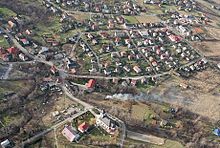Lipnik (Bielsko-Biała)
| Lipnik | ||
|---|---|---|
 Help on coat of arms |
|
|
| Basic data | ||
| State : | Poland | |
| Voivodeship : | Silesia | |
| Powiat : | Bielsko-Biała | |
| Gmina : | Bielsko-Biała | |
| Area : | 8.9 km² | |
| Geographic location : | 49 ° 49 ' N , 19 ° 5' E | |
| Residents : | 5885 (2006-12-31) | |
| Telephone code : | (+48) 33 | |
| License plate : | SB | |

Lipnik ( German Kunzendorf ) is a district ( Osiedle ) of Bielsko-Biała in the Silesian Voivodeship in Poland .
geography
Lipnik is located about 3 km east of the city center, on the Niwka (= German Au-Bach).
In 1900 Lipnik (with Leszczyny ) had an area of 2076 ha . The current district has 893.17 hectares.
Historically, it was divided to two parts: Lipnik Dolny ( dolny - down ) and Lipnik Górny ( górny - above ).
history
The place originated in the late 13th century. It was first mentioned in a document as the parish Lipnik in the tithe register of the year 1326 in the Auschwitz deanery of the Krakow diocese . The original name is of Slavic origin, derived from Linden (Polish lipa ). Later the German name Kunzendorf ( Cunczendorff [also incorrectly deciphered as Cziraczendorff] in districtu Osuianczimiensi sitam in 1443 (copy 1510),) and since then the village has been called with double names .
Politically, the village originally belonged to the Duchy of Auschwitz , which existed from 1315 during the period of Polish particularism . Since 1327 the duchy was under the feudal rule of the Kingdom of Bohemia . In 1457 the duchy and the village of Lipnyk were bought by Poland .
In 1499 it became the seat of a Starostei . 1548 would receive Lipnik by King Sigismund II. August the Magdeburg Law . The first mayor from 1549 to 1575 was Walenty Krzyszko . Krzyszko founded several places on the outskirts of Lipnik: the later town of Biała around 1560, Straconka (1550–1560), Międzybrodzie Lipnickie and Leszczyny .
Lipnik / Kunzendorf belonged to the Bielitz-Biala language island . In 1508 about 2/3 of the residents had names of German origin. In 1617 the report of an episcopal visitation from Cracow noted that the village was inhabited by Germans and heretics [Lutherans].
During the first partition of Poland in 1772, Lipnik became part of the new Kingdom of Galicia and Lodomeria of the Habsburg Empire (from 1804). In 1772 the construction of an imperial road from Vienna to Lemberg through Lipnik began (so far the old "Polish route" bypassed Lipnik in the north). In 1789 the Starostei was closed and Lipnik gradually became dependent on the city of Biała, later industrialized and urbanized on the border with Biała.
In 1900 the village (excluding Leszczyny) had 7,643 inhabitants, the majority were German speakers (67.7%), 32.5% were Polish, 81.3% were Roman Catholic, 6.5% were Jews and 932 (12th , 2%) of other beliefs (predominantly Protestant).
In 1918, after the end of the First World War and the collapse of the Austro-Hungarian monarchy, Lipnik came to Poland.
Lipnik was incorporated into the city of Biała (since 1951 Bielsko-Biała) in 1925. During the Second World War, the eastern, rural part of Lipnik was temporarily separated from Biała.
Personalities
- Egon Riss (1901–1964), a British architect of Austrian origin
- Johannes Volkelt (1848–1930), a German philosopher
- Artur Schnabel (1882–1951), an Austrian pianist and composer
- Karol Wojtyła, Sr. (1879–1941), the father of Pope John Paul II.
mayor
Mayor from 1867 to 1925:
- 1867–1877: Jakob Linnert
- 1877–1882: Johan Urbanke
- 1882-1894: Aleksander Gieldanowski
- 1894–1898: Friedrich Piesch
- 1898–1907: Wilhelm Zipser
- 1907–1920: Johan Hoffmann
- 1920–1925: Walter Piesch
Web links
Individual evidence
- ↑ a b c Rada Miejska w Bielsku-Białej: Program rewitalizacji obszarów miejskich w Bielsku-Białej na lata 2007–2013. (PDF) December 7, 2007, pp. 9–10 , accessed on May 21, 2015 (Polish).
- ↑ a b hałcnowski i bielsko-bialska wyspa językowa. Dziedzictwo językowe Rzeczypospolitej, 2014, accessed October 12, 2014 (Polish).
- ↑ a b Ludwig Patryn (ed): Community encyclopedia of the kingdoms and countries represented in the Imperial Council, edited on the basis of the results of the census of December 31, 1900, XII. Galicia , Vienna 1907.
- ^ Idzi Panic (editor): Bielsko-Biała. Monografia miasta . 2nd Edition. I. Bielsko od zarania do wybuchu wojen śląskich. Dzieje miasta w czasach prehistorycznych iw średniowieczu. Wydział Kultury i Sztuki Urzędu Miejskiego w Bielsku-Białej, Bielsko-Biała 2011, ISBN 978-83-60136-31-7 , Zaplecze osadnicze Bielska, p. 213 (Polish).
- ↑ January Ptaśnik (editor): Monumenta Poloniae Vaticana T.1 Acta Apostolicae Camerae. Vol. 1, 1207-1344 . Sums. Academiae Litterarum Cracoviensis, Cracoviae 1913, pp. 147-150 ( online ).
- ↑ Tomasz Jurek (editor): 9155 ( pl ) In: Słownik Historyczno-Geograficzny Ziem Polskich w Średniowieczu. Edycja elektroniczna . PAN . 2010-2016. Retrieved April 22, 2019.
- ^ Krzysztof Rafał Prokop: Księstwa oświęcimskie i zatorskie wobec Korony Polskiej w latach 1438-1513. Dzieje polityczne . PAU , Kraków 2002, ISBN 83-8885731-2 , p. 151 (Polish).
- ↑ Jerzy Polak, 2001, p. 44
- ↑ [1]
- ↑ Jerzy Polak. Zarys dziejów Lipnika. P. 358
literature
- Jerzy Polak: Zarys dziejów Lipnika . Stowarzyszenie "Lipnik", Bielsko-Biała 2002, ISBN 83-912192-0-8 (Polish).



